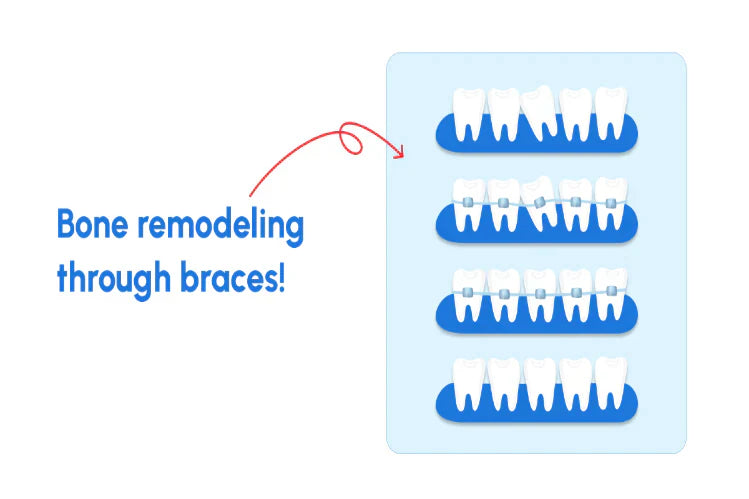
Avez-vous déjà réfléchi à la façon dont les appareils orthodontiques aident à redresser les dents ? Les appareils orthodontiques sont un traitement orthodontique basé sur La science ; ils déplacent vos dents en position par pression. Si vous envisagez un appareil dentaire pour vous-même ou votre enfant, connaître le fonctionnement du mécanisme des appareils dentaires sera utile pour comprendre vos options.
Voici tout ce que vous devez savoir sur l'alignement des dents, les appareils orthodontiques que vous trouverez aujourd'hui et les étapes de traitement par appareil dentaire. Nous aborderons également les avancées en orthodontie et évaluerons la façon dont des entreprises comme ALIGNERCO change le traitement orthodontique en nous proposant des options abordables à domicile pour redresser nos dents. dents.
Types d'appareils orthodontiques : aperçu de vos options
Les traitements orthodontiques ont beaucoup progressé ces dernières années, offrant aux patients plusieurs options parmi lesquelles choisir en fonction en fonction de leurs préférences personnelles, de leur budget et de la complexité de leurs besoins dentaires. Ils redressent leurs dents en appliquant pression continue sur une période donnée, ce qui déplace progressivement les dents vers leur position correcte. À mesure que les dents bougent, L'os qui les entoure change de forme pour s'adapter au nouvel alignement. Ce processus biologique est appelé remodelage osseux. l'orthodontie, et elle joue un rôle essentiel dans le processus de redressement des dents.
Voici un aperçu des principaux types d’appareils orthodontiques :
Aligneurs transparents

- Matériau : plateaux en plastique sans BPA.
- Apparence : Presque invisible.
- Fonction : Les aligneurs transparents sont amovibles et fabriqués sur mesure, appliquant une légère pression pour déplacer votre dents sans avoir besoin de fils ou de supports.
Avantages : Confortable, amovible et aucune restriction alimentaire.
Inconvénients : doivent être portés 20 à 22 heures par jour et ne conviennent pas aux cas graves.
Comment ça marche :
Les plateaux en plastique sur mesure déplacent progressivement les dents, chaque ensemble étant porté pendant 1 à 2 semaines avant de passer à l'ensemble suivant. la série.
Appareils dentaires en métal

- Matériau : supports et fils en acier inoxydable.
- Aspect : Très visible, avec une finition argentée classique.
- Fonction : Les appareils dentaires en métal sont incroyablement solides et poussent les dents dans leur position, ce qui en fait un excellente option pour les cas d'alignement des dents plus complexes.
Avantages : Abordable et très efficace, en particulier pour les désalignements sévères.
Inconvénients : visibles et peuvent irriter les gencives.
Comment ça marche :
Les brackets sont collés aux dents et reliés par un fil. L'orthodontiste resserre périodiquement le fil pour les appliquer. pression, guidant les dents en place.
Appareils dentaires en céramique

- Matériau : Composés céramiques qui se fondent dans la couleur naturelle de vos dents.
- Aspect : Moins visible que les appareils métalliques.
- Fonction : Les appareils orthodontiques en céramique fonctionnent de manière similaire aux appareils orthodontiques métalliques, mais offrent une apparence plus discrète.
Avantages : Esthétiquement attrayant grâce à leurs brackets de la couleur des dents.
Inconvénients : Plus fragile que les appareils métalliques et peut se tacher avec le temps.
Comment ça marche :
Ils fonctionnent comme des appareils métalliques, mais utilisent des brackets de la couleur des dents. L'arc exerce une pression pour déplacer les dents.
Appareils orthodontiques autoligaturants

- Matériau : Disponible en métal et en céramique.
- Apparence : Ils ressemblent aux appareils orthodontiques traditionnels mais comportent des clips plutôt que des élastiques.
- Fonction : Le mécanisme coulissant aide à maintenir le fil en place, réduisant ainsi la friction et permettant des réglages plus rapides et plus confortables.
Avantages : Moins de visites chez l’orthodontiste et une réduction de l’inconfort.
Inconvénients : Pas idéal pour tous les types de désalignement.
Comment ça marche :
Leur fonctionnement est similaire à celui des appareils orthodontiques traditionnels. Cependant, des clips remplacent les élastiques pour maintenir le fil, réduisant ainsi friction et potentiellement accélérer le traitement.
Appareils orthodontiques linguaux

- Matériau : Acier inoxydable.
- Apparence : Complètement cachés derrière les dents, les rendant invisibles lorsque vous souriez.
- Fonction : Ces appareils orthodontiques sont personnalisés pour s'adapter à l'arrière de vos dents et fonctionnent un peu comme du métal croisillons.
Avantages : Invisible lorsque vous souriez, offrant de la discrétion.
Inconvénients : cher, difficile à nettoyer et peut avoir un impact temporaire sur la parole.
Comment ça marche :
Des supports personnalisés sont placés à l'arrière des dents, en utilisant un mécanisme similaire à celui des appareils métalliques, mais cachés de la vue.
Étapes du traitement des appareils orthodontiques
Le processus d'obtention d'un appareil dentaire comporte plusieurs étapes distinctes, chacune cruciale pour le succès global de votre Traitement orthodontique. Voici un bref aperçu :
Consultation initiale
Votre orthodontiste examinera vos dents, prendra des radiographies et créera une empreinte de vos dents pour établir un diagnostic. Ou, si vous choisissez un traitement à domicile comme celui d'ALIGNERCO, vous pouvez répondre à un sondage rapide de 30 secondes pour Vérifiez votre admissibilité au traitement par aligneurs. Après l'achat du traitement, vous recevrez un kit d'empreintes pour entrées.
Pose d'appareils dentaires ou d'aligneurs en cours d'arrivée
Que vous utilisiez un appareil dentaire traditionnel ou des aligneurs transparents, cette étape consiste à ajuster l'appareil orthodontique. Pour les appareils dentaires métalliques, vous devrez consulter votre dentiste et les faire poser, mais si vous optez pour un appareil dentaire à domicile traitement avec ALIGNERCO, vos aligneurs transparents vous seront envoyés à votre porte, après avoir approuvé votre sourire 3D projection.
Phase d'ajustement
Au fil des mois, vos dents commenceront lentement à s'aligner. Vous consulterez régulièrement votre orthodontiste pour ajustements. Avec ALIGNERCO, plus besoin d'ajustements ni de visites chez le dentiste. Vous devez changer de prothèse. plateau d'alignement tous les 10 jours et vous pouvez suivre vos progrès avec l'application ALIGNERCO Tracker.
Étape de décollement ou d'alignement final
Votre orthodontiste retirera votre appareil dentaire une fois le traitement terminé. De même, vous porterez la gouttière d'alignement définitive. pendant la durée recommandée. La dernière étape pour un sourire plus droit consiste à assurer la stabilité avec un appareil de contention.
Phase de rétention
Après le retrait des appareils orthodontiques ou des aligneurs, des dispositifs de contention sont utilisés pour maintenir la nouvelle position de vos dents. traitement, vous devrez peut-être acheter des appareils de contention séparément, mais avec ALIGNERCO, vous obtenez vos appareils de contention dans le plan de traitement donc pas besoin de payer un supplément pour eux.
L'importance des appareils de contention après un appareil dentaire
Après avoir terminé votre traitement par appareil dentaire ou par aligneur, il est essentiel de porter des appareils de contention pour éviter que vos dents ne se cassent. revenant à leur position initiale. Cette tendance naturelle est appelée rechute. Les appareils de contention aident à maintenir la nouvelle position. l'alignement de vos dents et peut être fixe ou amovible.
- Appareils de contention fixes : collés derrière vos dents, idéaux pour une stabilité à long terme.
- Dispositifs de contention amovibles : fabriqués à partir d'une base en plastique transparent ou en acrylique et de fils métalliques, faciles à porter et faire le ménage.
Pourquoi ALIGNERCO se démarque sur le marché
Avec l'essor des traitements orthodontiques à domicile, ALIGNERCO s'est imposé comme un leader, offrant une solution abordable, Alternative pratique et efficace aux appareils orthodontiques traditionnels. Voici pourquoi ALIGNERCO gagne en popularité :
- Abordabilité : ALIGNERCO propose certaines des options les plus rentables pour redresser les dents, le rendre accessible à un plus large éventail de personnes.
- Traitement à domicile : L'ensemble du plan de traitement est initié à domicile, en commençant par une empreinte kit. Une fois renvoyé, les professionnels d'ALIGNERCO créeront un plan personnalisé.
- Forfait tout compris : Votre forfait de traitement comprend le kit d'empreintes, les aligneurs personnalisés, appareils de contention, extras comme un kit de blanchiment des dents, un écarteur de joues, une surveillance à distance et une assistance client 24h/24 et 7j/7.
- Assistance experte : les professionnels agréés d'ALIGNERCO vous offrent une assistance client 24h/24 et 7j/7, assurer un accompagnement professionnel tout au long du processus.
- Suivi facile avec l'application ALIGNERCO : suivez vos progrès et discutez avec des spécialistes via notre application Tracker conviviale.
Comment fonctionnent les appareils dentaires ?
Comprendre le fonctionnement des appareils orthodontiques et les différentes options disponibles pour le traitement orthodontique peut vous aider à prendre une décision plus éclairée. Prenez une décision éclairée pour obtenir un sourire droit et sain. Que vous optiez pour un appareil dentaire traditionnel ou des aligneurs transparents, les deux options ont leurs avantages uniques en fonction de vos besoins dentaires, de votre style de vie et de vos préférences esthétiques. Les appareils orthodontiques traditionnels restent une solution fiable pour les cas complexes, tandis que les aligneurs transparents offrent une solution plus discrète et traitement flexible, en particulier pour les personnes présentant des désalignements légers à modérés.
Le chemin vers des dents parfaites exige de la patience et de l'engagement, mais avec les progrès des appareils orthodontiques et des traitements comme ALIGNERCO, le processus est plus accessible et adapté aux préférences individuelles que jamais auparavant. Quel que soit le chemin que vous choisissez, vous êtes un peu plus près de profiter de la confiance d’un sourire magnifiquement aligné.
FAQ
1. Quel est le mécanisme par lequel les appareils orthodontiques déplacent les dents ?
Les appareils dentaires déplacent les dents en appliquant une pression douce et continue qui déclenche le remodelage osseux, en décomposant l'os d'un côté de la dent et en le construisant de l'autre pour déplacer les dents dans un alignement correct.
2. Combien de temps faut-il pour que les appareils dentaires redressent les dents ?
Cela dépend du type de traitement choisi. Un appareil dentaire traditionnel dure entre 1 et 2 ans, tandis qu'un traitement par aligneurs transparents dure entre 4 et 6 mois.
3. Les appareils dentaires font-ils mal lorsqu'ils commencent à déplacer les dents ?
Vous pouvez ressentir une légère douleur ou une légère pression, surtout après les ajustements, mais cela disparaît généralement en quelques jours.
4. Les appareils dentaires peuvent-ils corriger tous les types de désalignements dentaires ?
Oui, les appareils orthodontiques traditionnels peuvent traiter presque tous les types de malpositions, du léger encombrement aux problèmes d'occlusion sévères. Les aligneurs transparents ne conviennent qu'aux cas légers à modérés.
5. Quels sont les différents composants des appareils orthodontiques et leurs fonctions ?
Les brackets des appareils dentaires maintiennent les fils sur les dents, les arcs dentaires exercent une pression pour déplacer les dents, et les élastiques aident à guider l'alignement de la mâchoire. Avec les gouttières transparentes, les gouttières en plastique exercent une légère pression sur les dents pour les remettre en place progressivement.
Citations:
Watson, K. (14 janvier 2019). Comment les appareils orthodontiques redressent les dents chez les enfants et les adultes . Healthline. https://www.healthline.com/health/how-do-braces-work? #types-of-braces
Professionnel, CCM (2025b, 19 mars). Appareils dentaires . Clinique de Cleveland. https://my.clevelandclinic.org/health/treatments/24601-teeth-braces






